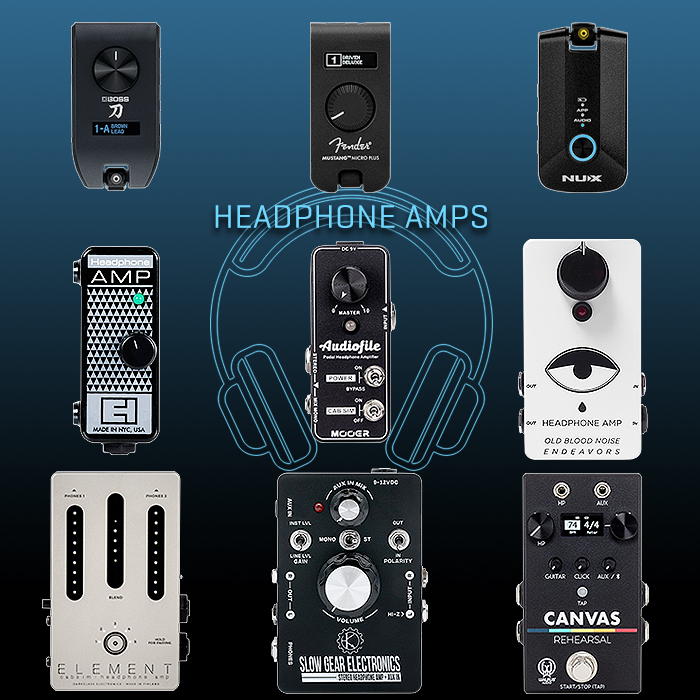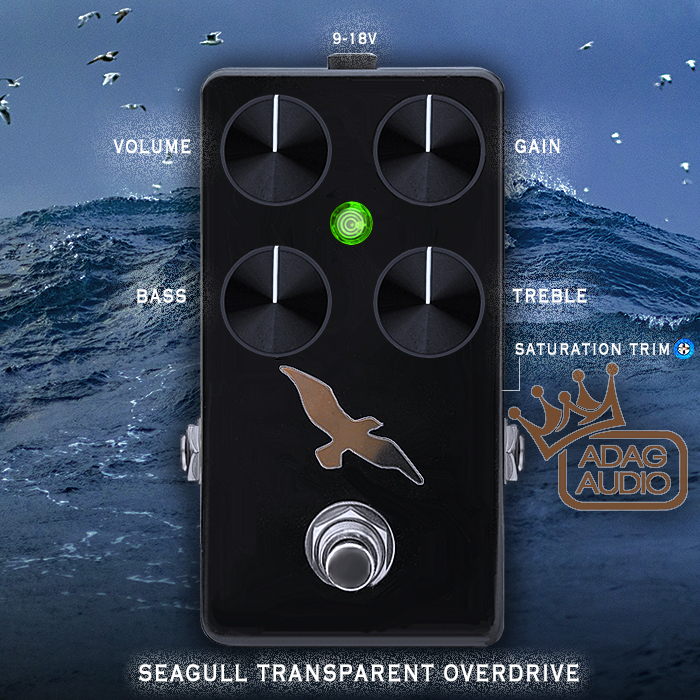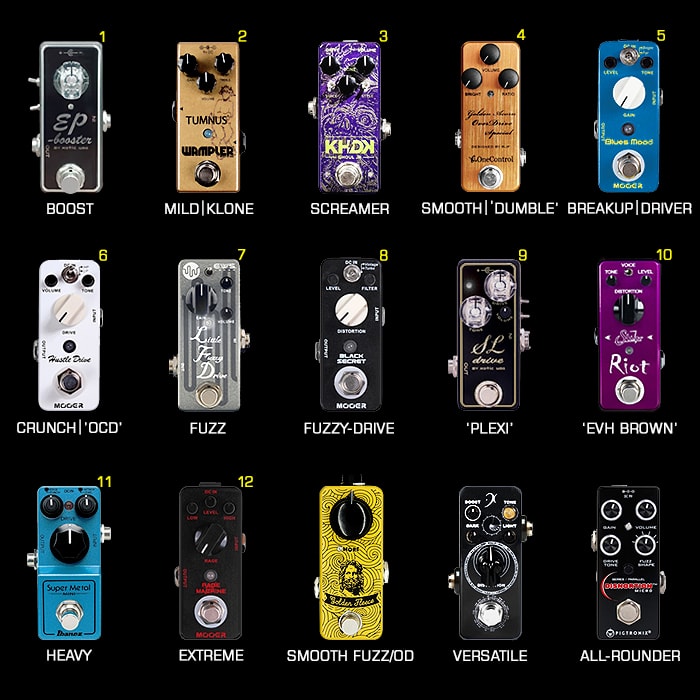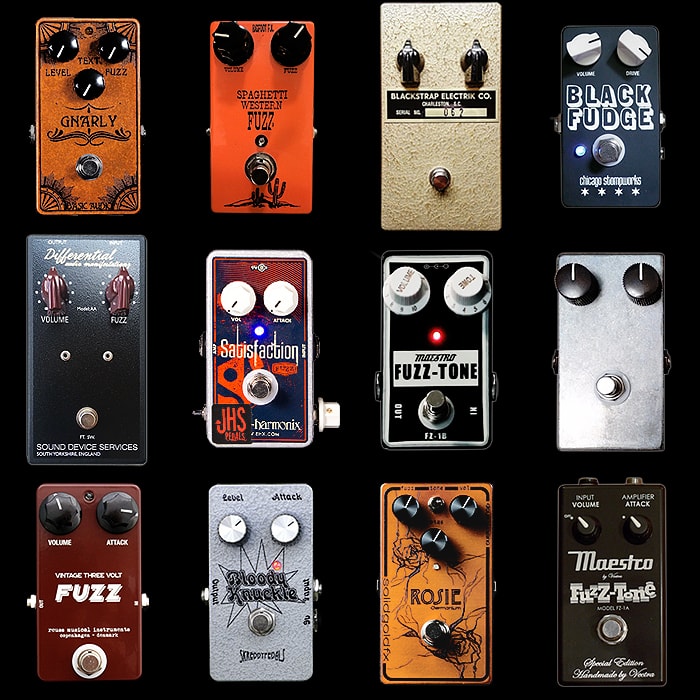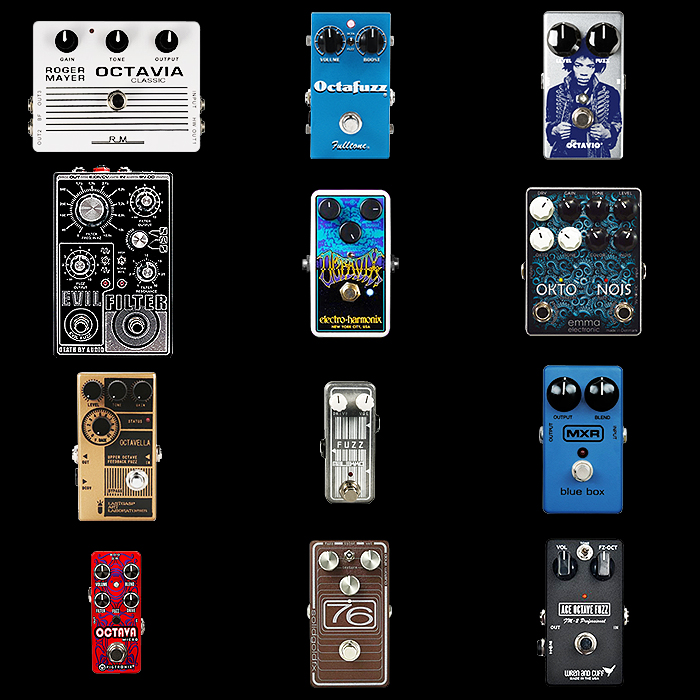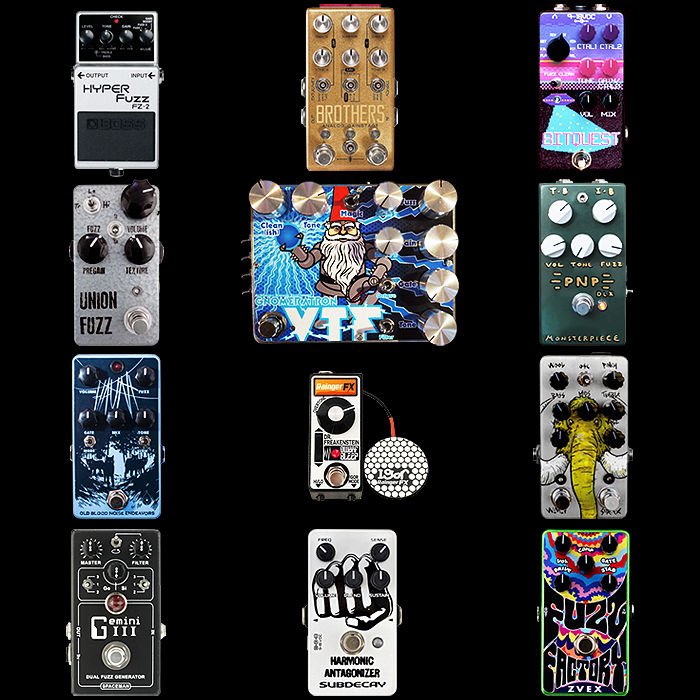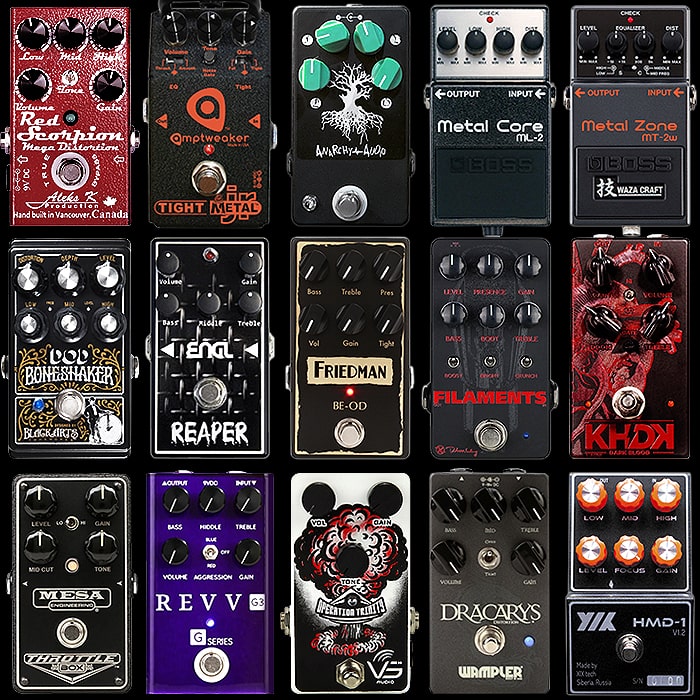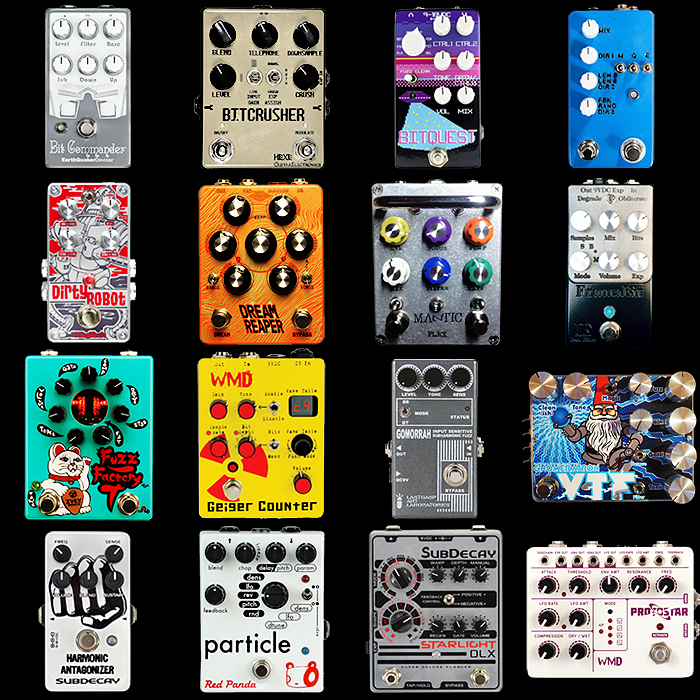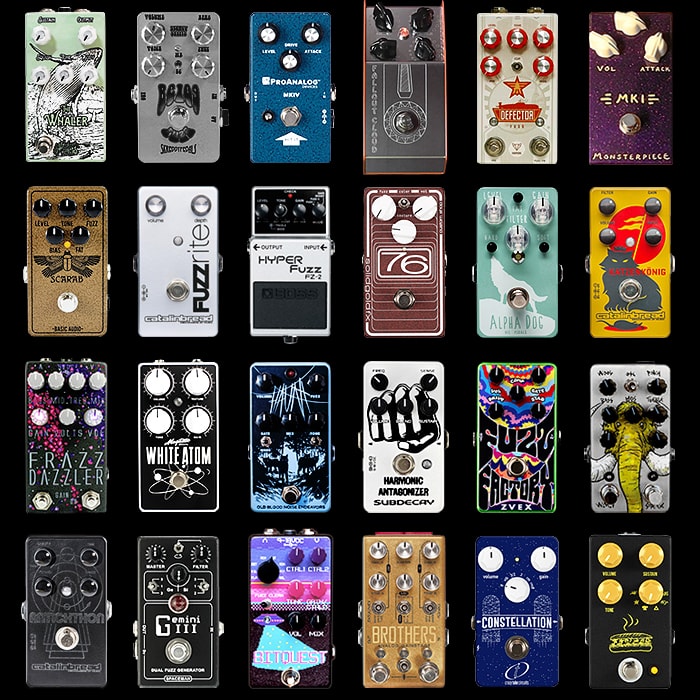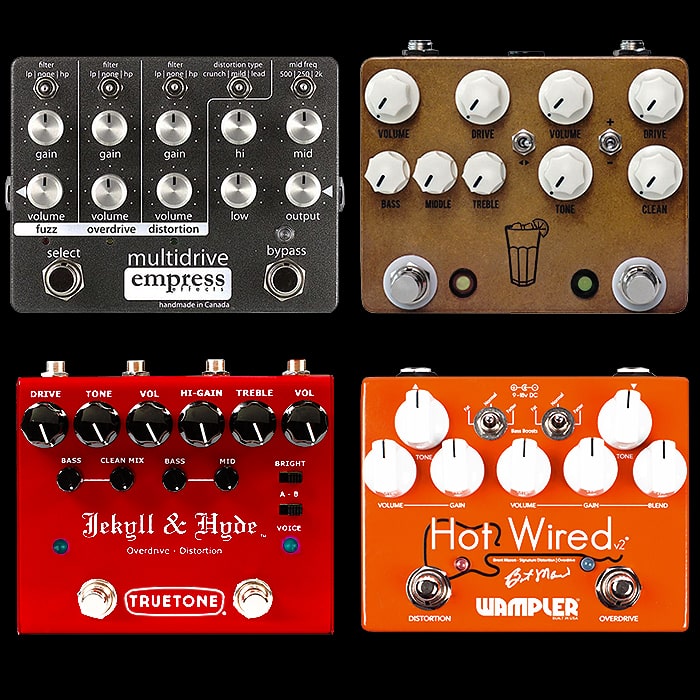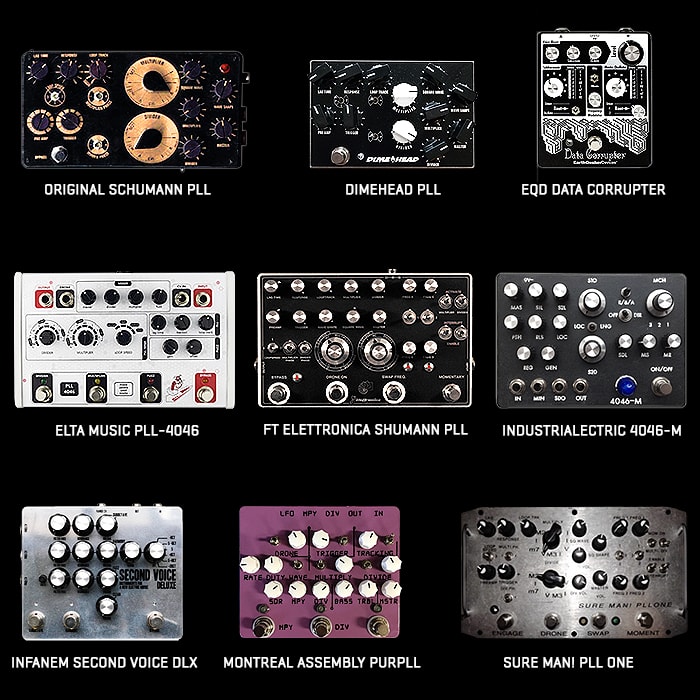12 of the Best Harmonic Percolator Style Fuzzstortion Pedals
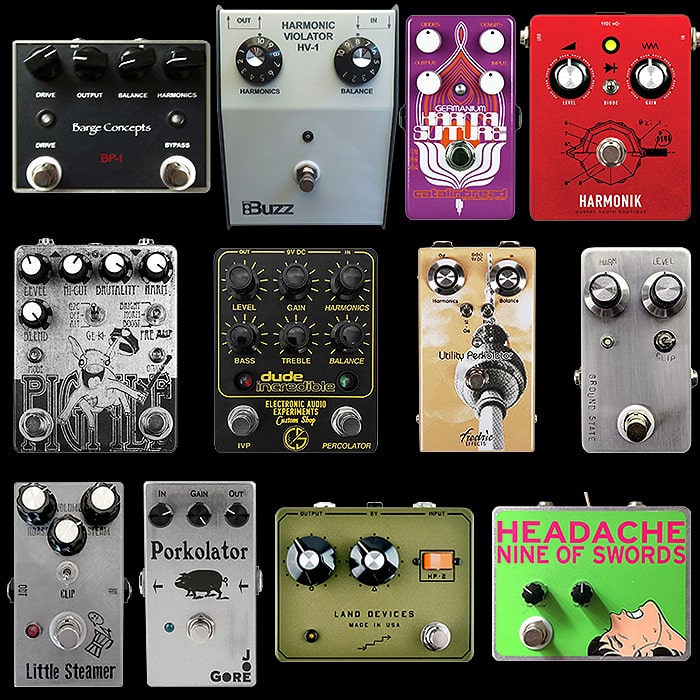
The celebrated InterFax HP-1 Harmonic Percolator which became a major part of Shellac Guitarist Steve Albini’s signature sound had somewhat obscure origins in the early 1970’s at a Milwaukee, Wisconsin electronics repair shop run by one Ed Giese. The Harmonic Percolator makes use of rather unique circuitry utilising a combination of very obscure Germanium PNP and Silicon NPN Transistors (2N404A/1N695 + 2N3565) which pass through even order harmonics while suppressing odd order harmonics - resulting in a particularly pleasing fuzzy distortion tone. I personally consider this one of the 3 key cornerstones of a certain breed of Fuzzstortion type pedals - along with the Rat type, and Sunn Model T.
The original form factor consisted of a typically 70’s style over-sized enclosure with just 2 slider controls besides the footswitch - Harmonics and Balance. The left slider (Harmonics) is actually the input gain or distortion control while the right one (Balance) is the output control - which is typically the opposite of modern topology. If you want an exact replica down to the last detail using original old stock transistors and identical enclosure with rare components then Chuck Collins of Theremaniacs is your supplier of choice for $295 a pop.
Readers of this blog though will know that I'm not a fan of over-sized vintage / old school enclosures however amazing those pedals can sound - they usually bring with them all manner of complicated ownership challenges - like odd power supply requirements, rigid pedalboard position/placement - and obviously an enormous footprint. If I really can, I prefer to have everything in as compact an enclosure as possible - with concessions made for all-round modulation, delay and reverb workstation pedals obviously - generally though for individual effects I want them as compact, practical and versatile as possible which brings us nicely to this particular grouping of 12.
I've been loosely aware of the Harmonic Percolator for a while - recalling recent pedals from Joe Gore and Land Devices - but what triggered this particular feature was the very recent announcement from Joe's Pedals that he had the last ever copies in stock of the Dude Incredible from Electronic Audio Experiments - a combination of Harmonic Percolator on the right-hand side and Intersound Instrument Voice PreAmp on the left - which can be selected independently or stacked. I believe I snagged the very last copy of those. Said pedal just looked and sounded really interesting, and to be fair I had not done a whole lot of due diligence on it when I hit the trigger - snooze and you lose at it were!
In the wake of the Dude Incredible acquisition I then did the research to see how it fared against the other contenders in the category that I was able to unearth - and this article is the result of said survey. As mentioned above - if you want the very best exact replica - then the Theremaniac version is definitely the one to go for - properly authentic - it does though come with most of the challenges of owning the original! For me it's about capturing that flavour - as near as darnit but with practical modern considerations applied.
The two most interesting varieties for me here are the Electrofoods Ultd. Pigpile and the Dude Incredible that I recently acquired - they are both medium-size vertical enclosure - we have a few medium horizontal enclosure varieties also alongside with a number of compacts. As already mentioned - the most recent additions as far as I am aware are the Joe Gore and Land Devices varieties, while I've been aware of the Catalinbread Karma Suture for the longest time - but not until recently have I really associated it with the Harmonic Percolator genre. I also have a passing acquaintance with the two varieties of Harmonic Percolator by Fredric Effects, but most of these pedals listed are new to me as such.
Pedals are listed alphabetically by brand as usual:
Barge Concepts BP-1 4-knob (discontinued) - c£100 (Reverb.com)
These were initially produced some 10 years ago first as a 3-knob version, and then latterly with a 4 knob arrangement as pictured, but seem to have been discontinued largely owing to manufacturing inconsistencies; they can also be notoriously temperamental and can have a tendency towards a high pitched squeal or whistling sound. Generally few and far between nowadays - I guess the better examples are being held onto by their owners while the less reliable ones hit Reverb.com every now and again. Instead of the 2 dials of the original - Harmonics and Balance - you get 4 here - Drive | Output | Balance | Harmonics - which includes a secondary 'Drive' gain stage. This pedal can sound great if you come upon the right one and hit the right combination of setting - and have the patience to tune it in - but it's possibly too fussy in use for most players.
Buzz Sound Harmonic Violator (discontinued?) - c£150 (Reverb.com)
So this is actually my final find for this group - even though alphabetically it appears second. This rather over-sized enclosure Percolator is very true to the original - with just the two dials - Harmonics (Gain) and Balance (Volume). Made by Belarusian builder Buzz Sound which looks to be still active, although I'm not clear whether this particular pedal still is. It nevertheless makes an appearance on Reverb.com every now and again. Way too large for my own preferences, but possibly appealing to someone with a more vintage mindset. It's still not quite as large as the original InterFax version as far as I can see - so that may be a bonus!
Catalinbread Germanium Karma Suture - £137
This comes in both Germanium and Silicon varieties - and is described as a Fuzz based on the Harmonic Percolator rather than a direct sort of replica. Controls here are - Diodes (Bias), Density (Saturation), Output and Input. There's plenty of these in distribution and this is a very decent gateway pedal into the genre, albeit not quite as raw and textured as the originals and more closely engineered replicas - really lovely sounding though and pretty aggressive nevertheless.
Dubrek Audio Boutique Harmonik Germanium Fuzz - £99
A British-made sort of replica of the Harmonic Percolator with the classic 2 controls - here more sensibly labelled Level and Gain. You also get a Germanium Diode clipping switch which introduces kind of squashed octave-like tones. It's currently discounted to £99, down from £129 - and Jay Dean has made a number of engineering updates here to make this pedal all-round better behaved and more usable - while still maintaining its classic raw texturised character. A really decent contender.
Electrofoods Ultd. Pigpile Hamonic Porkolating Fuzz - £165 (Reverb.com)
Electrofoods state very specifically that this is not a clone, but an 'inspired by' pedal with lots of extra bells and whistles. First off you get 5 dials - Level | Hi-Cut | Brutality | Harmonics | Blend, next 2 x 3-way toggle switches for Germanium Clipping - Q2C (default) | Off | Alt (Alternative clipping set by internal dip-switches; and finally 3 different Pre Amp settings - Bright | Normal | Boost. We also have dual footswitches - Mode and On/Off(Byppas) - where mode is really a sort of Havoc style switch to extend the range of 'Brutality'. This pedal can be nicely used across the spectrum from relatively well-behaved moderate overdrive - and through to the textured kind of fuzzstortion we expect of a Harmonic Percolator - this one is very definitely under consideration for me. Note that it is currently out of stock on the Electrofoods Reverb.com shop - but more will appear eventually! Actually - there is one Mint version currently available on the site!
Electronic Audio Experiments Dude Incredible (Harmonic Percolator + IVP) (On Hiatus!) - £229
This is the one I acquired recently - on the EAE Catalogue it says this pedal is currently on hiatus - so unknown at the moment if there will be any more. This is a dedicated Steve Albini tone machine - intended to give you his 2 main flavours - which you can play independently or stack together with the Harmonic Percolator side into the Intersound Instrument Voice PreAmp side. The right-hand Percolator side has just the 2 classic controls - Harmonics (Gain) and Balance (Level), while the left-hand IVP side has Level | Gain | Bass | Treble for significantly more tone-shaping. Generally the pedal is intended to be mostly IVP side with the Percolator accentuating things when necessary - and while not an exact component replica of the Percolator - it nevertheless gives you pretty much exactly those tones. I love the form-factor and versatility on this - and the fact that I can temper the Harmonic Percolator with the IVP side - this is a really handy and fairly unique unit, and it makes for a great addition to my tone library.
Fredric Effects Utility Percolator MKII - £140
Fredric Effects has a couple of Harmonic Percolator varieties in its catalogue - and my preference is for the sleek new wedge-shape version Utility Percolator - which has the Standard Harmonics (Gain) and Balance (Level) dials - here alongside Silicon and Germanium clipping switch and Ring Modulator switch - which adds a cool splattery upper octave. The circuit has been significantly refined with Low Pass filter to screen out the glitchy high frequency hisses and glitches often associated with this sort of circuit. You get an overall much better behaved pedal - with all the key Percolator texture still fully intact. Probably my pick of the compact editions here.
Ground State Devices Percolating Distortion / Fuzz - £124 (Reverb.com)
This is Paul MacLellan's accurate / compact take on the Harmonic Percolator and features an original 2n404 Germanium Transistor alongside a Clipping switch which allows you to switch out the Germanium clipping diodes for a more controlled and punchy sound. Solid and elegant build if a touch utilitarian - the two main controls here are labelled Harmonics (Gain) and Level on this occasion. This pedal is currently available on Reverb.com at a discount - certainly worth a gamble if you are so minded! Note that there is no specific demo video available for this pedal yet - albeit the builder does reference the Theremanicas / Chuck Collins video as a near reference! So a gamble for sure.
JDM Pedals Little Steamer Overdrive - $129 (JoeDocMusic.com)
Joe Doc'c compact version of the Harmonic Percolator comes with 3 dials and a clipping toggle switch. The dials are - Roast | Volume | Steam - where Roast is essentially Gain, while Steam is a sort of gain character with sparkle maintained when fully dialled back, and increasingly darker, harsher and more focused to the right. The clipping switch lets you go up another level by introducing a series of Silicon and Germanium Diodes which further increase gain and harmonic content. I would probably go for either this one or the Utility Percolator at the compact enclosure size.
Joe Gore Porkolator Distortion - $189 (VintageKing.com)
Joe Gore's take on the Percolator - the 3-knob Porkolator is a component correct but a slight circuit deviation on the original. The gain knob is a proper mid-circuit gain control, In is the Input Capacitance - which takes you from sparkly to full texture, and Out is the Volume or Level. The 'Harmonics' control of the original has been relegated in this instance to your own guitar volume knob which has exactly the same effect on the output. This is a beautifully tuned refined tone machine - possibly not quite as raw as the original, but it has a more extended range of usable tones - particularly on the more medium gain overdrive side of things. Another very fine variation on the theme. I came across the Porkolator first courtesy of my favourite Guitar magazine - Premier Guitar - where the pedal was reviewed in September of last year.
Land Devices HP-2 Distortion - $185 (LandDevices.bigcartel.com)
The other Percolator that I recently came across is this Land Devices medium-enclosure HP-2 - this was also reviewed by Premier Guitar - back in May of last year. It maintains the classic 2 dials (Harmonics/Gain/Input and Balance/Level/Output) - but also has an on/off clipping rocker switch which engages a Germanium Diode. This is another component-faithful take on the Percolator and bar the additional clipping option is pretty much largely as close to the original circuit as possible - just in a more convenient enclosure than the original.
Nine of Swords Headache Fuzz - £49 (TheFuzzShack.com)
By far the lowest cost option here - but lacking in LED indicator light which may be a big deal for some. This is another pretty faithful circuit replica with the classic 2 dials - Harmonics (Gain) and Balance (Output Level) - and just single footswitch. It does though have a further clipping toggle switch along the top edge of the pedal - which sort of boosts the Germanium Diode clipping - to give you an even meatier distortion. Unusual artwork will surely be marmite for some - but I'm cool with it. It's really not that different to the Land Devices HP-2 above - give or take a few aesthetic details.
Final Thoughts
There were a couple of more pedals that cropped up in the discovery process - the Robo Pedals Demonic Prick and SiC Effects Harmonic Percolator - but I struggled to find further details or video evidence of those - so I went with those which had the greater provenance as such. Possibly I overlooked one or two - which I hope you readers will be kind enough to point out to me if that is the case.
Of the ones that made the listing - my two favourites here are likely the more versatile Electrofoods Pigpile and the EAE Dude Incredible which prompted this article. Beyond that there are things I like about each of the Karma Suture, Utility Percolator, Little Steamer and Porkolator. As to which if any of those I additionally acquire - as usual it will depend on pricing and availability - although it really is about time I added a Fredric Effect to the tone library - so that is probably the forerunner of those.
As for other tone chasers - it's the usual mix of how authentic you want to be - what you're prepared to spend, and how much space you're willing to give over to this particular flavour. For me this will always be an additional flavour - rotated into the pedal-chain on an occasional basis - rather than a permanent key tone fixture - so depending on emphasis - you may be willing to go larger or smaller as to how significant this tonality is to your core sound. The Harmonic Percolator is definitely a distinct voice and something different to the norm.










